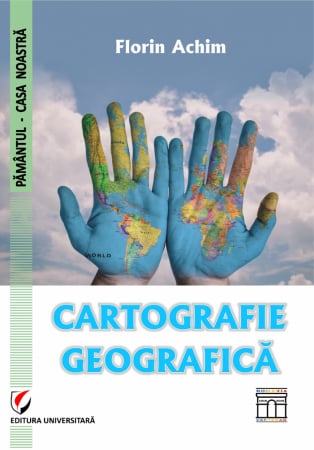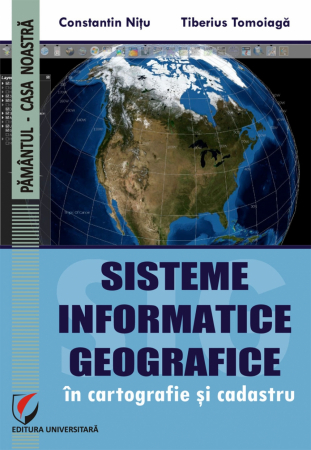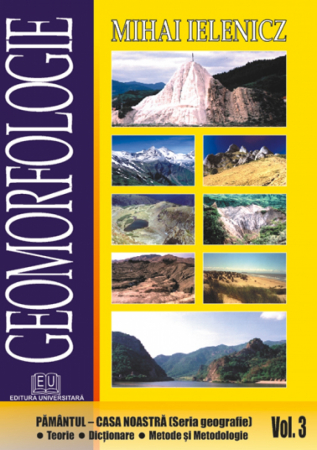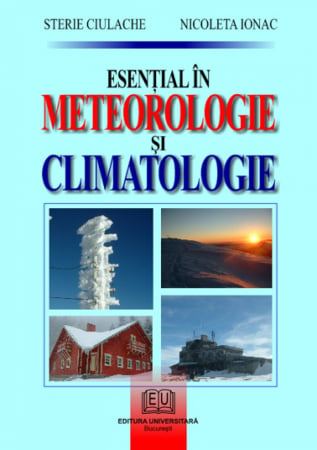Manuscript proposals: [email protected] / 0745 204 115 //// Tracking orders Individuals / Sales: 0745 200 357 / Orders Legal entities: 0721 722 783
ISBN: 978-606-591-109-3
Publisher year: 2011
Edition: II
Pages: 232
Publisher: Editura Universitară
Author: Gabriela Manea
Product Code:
9786065911093
Do you need help?
0745 200 357
- Description
- Download (1)
- Authors
- Content
- More details
- Reviews (0)
The book, entitled simply: "Elements of biogeography", is an attempt to synthesize information with theoretical and practical values in the field of biogeography, designed to stimulate students' curiosity, to help them understand the mechanisms of biotic envelope - so perfect and perhaps, that is why they are so vulnerable - to initiate them in the research techniques of the living world, to sensitize them and to motivate their actions directed towards the protection and conservation of floristic and faunal species. Its content is structured in four parts, which address: theoretical problems of taxonomy, ecology and chorology; structural and behavioral characteristics of the plant and animal communities within the large continental biomes; aspects related to the need for protection and conservation of the biotic envelope; research methods and techniques used in biogeographic studies. Through the content and the approached issues, the paper is addressed especially to students who, according to the Curriculum, study biogeography during a single semester. At the same time, the information contained in the book can be a source of information for teachers in pre-university education, who choose biogeography or certain biogeography issues as an optional subject.
-
Elemente de biogeografie
Download
GABRIELA MANEA
Foreword / 5
PART I - FUNDAMENTAL NOTIONS OF TAXONOMY, ECOLOGY AND CHOROLOGY
Chapter I. Concepts regarding the content of biogeography / 13
1.1. Biosphere - object of study of biogeography; the relationship of biogeography with the other branches of physical geography / 13
1.2. Biosphere boundaries / 16
Chapter II. Notions of taxonomy and ecology used in biogeography / 19
2.1. Overview of the vegetal taxonomic scale / 20
2.2. Overview of the animal taxonomic scale / 21
2.3. General organization of the biosphere: individual, population, biocenosis, biome, biosphere / 24
2.4. The abiotic-biotic relationship within the biosphere; ecological rules / 25
2.5. Biocenoses or communities; structure of biocenoses / 26
2.6. Ecological niche and habitat / 28
2.7. Ecosystems / 29
Chapter III. Dynamics of life forms in geological time / 36
Chapter IV. Environmental factors and their relations with living organisms / 49
4.1. Abiotic factors with a determining role in the geographical distribution of living organisms / 49
4.1.1. Light / 49
4.1.2. Temperature / 51
4.1.3. Water factors / 55
4.1.4. Soil factors / 58
4.1.5. Geomorphological factors / 59
4.1.6. Abiotic factors with mechanical action on living organisms / 60
4.1.7. Plants - indicators of the quality of the living environment / 62
4.1.8. Biological spectrum - result of the adaptation to the environment of floristic species. Categories of bioforms / 76
4.2. Biotic factors and their influence on organisms; intraspecific relations and interspecific relations / 80
4.2.1. Typology of intraspecific relations / 80
4.2.2. Typology of interspecific relations / 81
4.3. The impact of biocenosis activity on the biotope / 85
4.3.1. The impact of the biocenosis on the climatic conditions of the biotope / 85
4.3.2. The impact of forest biocenoses on current hydrological and geomorphological processes / 85
4.3.3. The impact of the biocenosis on the edaphic coating / 86
4.3.4. The impact of biocenosis on the aquatic biotope / 87
4.4. The anthropic factor and its relations with living organisms / 87
Chapter V. The biogeographical area / 92
5.1. Biogenetic center and formation of biogeographic areas / 92
5.2. Dissemination of organisms and their role in the formation of biogeographic areas / 93
5.2.1. Active dissemination - autocoria / 93
5.2.2. Types of passive dissemination - anemocoria, hydrocoria, zoocoria and man-made dissemination / 93
5.3. Characteristics of biogeographical areas / 95
5.4. Area - geographical affiliation of floristic species in Romania. (The phytogeographical spectrum of Romania) / 103
PART II - CONTINENTAL BIOMORS
Chapter I. Closed continental biomes / 111
1.1. Wet equatorial or tropical forests / 111
1.2. Tropical forests with seasonal rhythm / 119
1.3. Mediterranean forests and bushes / 122
1.4. The immoral forests of the northern hemisphere (temperate forests with falling leaves) / 128
1.5. Boreal forests / 135
1.6. North American Pacific Coastal Forests / 141
Chapter II. Open continental biomes / 142
2.1. Arctic Tundra / 142
2.2. Eurasian steppe / 147
2.3. American Prairie / 151
2.4. South American Pampas / 153
2.5. Savannahs and savannah plant formations / 156
2.6. Arid domains / 161
PART III - ELEMENTS OF CONSERVATIONIST BIOGEOGRAPHY
Chapter I. Extinction of species / 171
1.1. Natural extinction / 171
1.2. Cultural extinction of species / 172
Chapter II. Arguments in favor of preserving the living world / 175
Chapter III. Strategies for the protection and conservation of the living world / 177
3.1. In situ conservation strategies / 177
3.1.1. Protected natural areas classified by IUCN / 177
3.1.2. Categories of protected areas dependent on international programs (MAB) and international conventions / 180
3.1.3. Protected areas included in the “Natura 2000” network, due to the process of Romania's integration in the EU / 183
3.2. Ex situ conservation strategies / 184
3.2.1. Increasing in captivity and reintroducing wild species into their natural environments / 184
3.3. Protected areas, ecological planning and management / 185
3.4. Protected areas and local sustainable development / 186
3.5. Protected areas and spatial planning / 186
3.6. Protected areas and sustainable tourism / 187
3.7. Management of protected areas / 187
3.8. Prevention of failure of protected areas / 188
PART IV - STAGES AND RESEARCH METHODS IN BIOGEOGRAPHY
Chapter I. Research stages / 191
Chapter II. Methods frequently used in the elaboration of biogeographic studies. Techniques for applying and interpreting the results / 199
2.1. Cartographic representation of the area of a species / 200
2.2. Determination and graphic representation of the phytogeographical spectrum of a territory or of a vegetal formation / 204
2.3. Determination and graphical representation of the biological spectrum / 205
2.4. Appreciations on the architectural model of the format vegetation, with the help of biogeographic files and vegetation pyramids / 205
2.5. Notions of phenology; determination of the duration of the vegetation season with the help of the histophenogram / 212
2.6. Numerical methods for assessing the characteristics of the ecological potential of a territory / 216
2.7. Graphic methods for assessing the ecological potential of a territory / 219
2.8. Biogeographic profile / 224
SELECTIVE BIBLIOGRAPHY / 229
PART I - FUNDAMENTAL NOTIONS OF TAXONOMY, ECOLOGY AND CHOROLOGY
Chapter I. Concepts regarding the content of biogeography / 13
1.1. Biosphere - object of study of biogeography; the relationship of biogeography with the other branches of physical geography / 13
1.2. Biosphere boundaries / 16
Chapter II. Notions of taxonomy and ecology used in biogeography / 19
2.1. Overview of the vegetal taxonomic scale / 20
2.2. Overview of the animal taxonomic scale / 21
2.3. General organization of the biosphere: individual, population, biocenosis, biome, biosphere / 24
2.4. The abiotic-biotic relationship within the biosphere; ecological rules / 25
2.5. Biocenoses or communities; structure of biocenoses / 26
2.6. Ecological niche and habitat / 28
2.7. Ecosystems / 29
Chapter III. Dynamics of life forms in geological time / 36
Chapter IV. Environmental factors and their relations with living organisms / 49
4.1. Abiotic factors with a determining role in the geographical distribution of living organisms / 49
4.1.1. Light / 49
4.1.2. Temperature / 51
4.1.3. Water factors / 55
4.1.4. Soil factors / 58
4.1.5. Geomorphological factors / 59
4.1.6. Abiotic factors with mechanical action on living organisms / 60
4.1.7. Plants - indicators of the quality of the living environment / 62
4.1.8. Biological spectrum - result of the adaptation to the environment of floristic species. Categories of bioforms / 76
4.2. Biotic factors and their influence on organisms; intraspecific relations and interspecific relations / 80
4.2.1. Typology of intraspecific relations / 80
4.2.2. Typology of interspecific relations / 81
4.3. The impact of biocenosis activity on the biotope / 85
4.3.1. The impact of the biocenosis on the climatic conditions of the biotope / 85
4.3.2. The impact of forest biocenoses on current hydrological and geomorphological processes / 85
4.3.3. The impact of the biocenosis on the edaphic coating / 86
4.3.4. The impact of biocenosis on the aquatic biotope / 87
4.4. The anthropic factor and its relations with living organisms / 87
Chapter V. The biogeographical area / 92
5.1. Biogenetic center and formation of biogeographic areas / 92
5.2. Dissemination of organisms and their role in the formation of biogeographic areas / 93
5.2.1. Active dissemination - autocoria / 93
5.2.2. Types of passive dissemination - anemocoria, hydrocoria, zoocoria and man-made dissemination / 93
5.3. Characteristics of biogeographical areas / 95
5.4. Area - geographical affiliation of floristic species in Romania. (The phytogeographical spectrum of Romania) / 103
PART II - CONTINENTAL BIOMORS
Chapter I. Closed continental biomes / 111
1.1. Wet equatorial or tropical forests / 111
1.2. Tropical forests with seasonal rhythm / 119
1.3. Mediterranean forests and bushes / 122
1.4. The immoral forests of the northern hemisphere (temperate forests with falling leaves) / 128
1.5. Boreal forests / 135
1.6. North American Pacific Coastal Forests / 141
Chapter II. Open continental biomes / 142
2.1. Arctic Tundra / 142
2.2. Eurasian steppe / 147
2.3. American Prairie / 151
2.4. South American Pampas / 153
2.5. Savannahs and savannah plant formations / 156
2.6. Arid domains / 161
PART III - ELEMENTS OF CONSERVATIONIST BIOGEOGRAPHY
Chapter I. Extinction of species / 171
1.1. Natural extinction / 171
1.2. Cultural extinction of species / 172
Chapter II. Arguments in favor of preserving the living world / 175
Chapter III. Strategies for the protection and conservation of the living world / 177
3.1. In situ conservation strategies / 177
3.1.1. Protected natural areas classified by IUCN / 177
3.1.2. Categories of protected areas dependent on international programs (MAB) and international conventions / 180
3.1.3. Protected areas included in the “Natura 2000” network, due to the process of Romania's integration in the EU / 183
3.2. Ex situ conservation strategies / 184
3.2.1. Increasing in captivity and reintroducing wild species into their natural environments / 184
3.3. Protected areas, ecological planning and management / 185
3.4. Protected areas and local sustainable development / 186
3.5. Protected areas and spatial planning / 186
3.6. Protected areas and sustainable tourism / 187
3.7. Management of protected areas / 187
3.8. Prevention of failure of protected areas / 188
PART IV - STAGES AND RESEARCH METHODS IN BIOGEOGRAPHY
Chapter I. Research stages / 191
Chapter II. Methods frequently used in the elaboration of biogeographic studies. Techniques for applying and interpreting the results / 199
2.1. Cartographic representation of the area of a species / 200
2.2. Determination and graphic representation of the phytogeographical spectrum of a territory or of a vegetal formation / 204
2.3. Determination and graphical representation of the biological spectrum / 205
2.4. Appreciations on the architectural model of the format vegetation, with the help of biogeographic files and vegetation pyramids / 205
2.5. Notions of phenology; determination of the duration of the vegetation season with the help of the histophenogram / 212
2.6. Numerical methods for assessing the characteristics of the ecological potential of a territory / 216
2.7. Graphic methods for assessing the ecological potential of a territory / 219
2.8. Biogeographic profile / 224
SELECTIVE BIBLIOGRAPHY / 229
The earth we live on - "Miracle Planet" never ceases to amaze us, to put us in front of mysteries, often too difficult to solve, to provide us with vital resources, apparently, without asking for anything in return, to bear our whims, but to sanction us when we exceed the measure. Of all the wonders of the blue planet, life is without a doubt the most precious treasure; in its absence, who else could enjoy all the other gifts of the Earth: water, air, minerals, light, heat ?!
In an era of quasi-generalized industrialization and urbanization, each of us seeks a living corner, enlivened by the rustling of leaves, the scent of flowers, the trills of birds, and the hum of insects; every human being can find in the middle of nature a source of delight, energy and inspiration. At the same time, paradoxically, man has today become the most feared enemy of plants and animals on Earth. The unfair competition of man with other living beings, revealed by the extinctions due to human activities in historical time, means that, in the short, medium and long term, the existence of many floristic and faunal species is called into question.
The book, entitled simply: "Elements of biogeography", is an attempt to synthesize information with theoretical and practical values in the field of biogeography, designed to stimulate students' curiosity, to help them understand the mechanisms of biotic envelope - so perfect and perhaps, that is why they are so vulnerable - to initiate them in the research techniques of the living world, to sensitize them and to motivate their actions directed towards the protection and conservation of floristic and faunal species. Its content is structured in four parts, which address: theoretical problems of taxonomy, ecology and chorology; structural and behavioral characteristics of the plant and animal communities within the large continental biomes; aspects related to the need for protection and conservation of the biotic envelope; research methods and techniques used in biogeographic studies. Through the content and the approached issues, the paper is addressed especially to students who, according to the Curriculum, study biogeography during a single semester. At the same time, the information contained in the book can be a source of information for teachers in pre-university education, who choose biogeography or certain biogeography issues as an optional subject.
Through this paper, I would like to thank the professors who introduced me to the secrets of biogeography, first in my student years and, later, during my university career: the late Prof. Ioan Pisota, the teacher who, through the prestige doubled by the sense of humor, aroused my interest for this study discipline and Mrs. prof.univ.dr. Maria Patroescu - mentor, collaborator and often constructive critic of the activity carried out by the undersigned in the service of biogeography.
The Author
In an era of quasi-generalized industrialization and urbanization, each of us seeks a living corner, enlivened by the rustling of leaves, the scent of flowers, the trills of birds, and the hum of insects; every human being can find in the middle of nature a source of delight, energy and inspiration. At the same time, paradoxically, man has today become the most feared enemy of plants and animals on Earth. The unfair competition of man with other living beings, revealed by the extinctions due to human activities in historical time, means that, in the short, medium and long term, the existence of many floristic and faunal species is called into question.
The book, entitled simply: "Elements of biogeography", is an attempt to synthesize information with theoretical and practical values in the field of biogeography, designed to stimulate students' curiosity, to help them understand the mechanisms of biotic envelope - so perfect and perhaps, that is why they are so vulnerable - to initiate them in the research techniques of the living world, to sensitize them and to motivate their actions directed towards the protection and conservation of floristic and faunal species. Its content is structured in four parts, which address: theoretical problems of taxonomy, ecology and chorology; structural and behavioral characteristics of the plant and animal communities within the large continental biomes; aspects related to the need for protection and conservation of the biotic envelope; research methods and techniques used in biogeographic studies. Through the content and the approached issues, the paper is addressed especially to students who, according to the Curriculum, study biogeography during a single semester. At the same time, the information contained in the book can be a source of information for teachers in pre-university education, who choose biogeography or certain biogeography issues as an optional subject.
Through this paper, I would like to thank the professors who introduced me to the secrets of biogeography, first in my student years and, later, during my university career: the late Prof. Ioan Pisota, the teacher who, through the prestige doubled by the sense of humor, aroused my interest for this study discipline and Mrs. prof.univ.dr. Maria Patroescu - mentor, collaborator and often constructive critic of the activity carried out by the undersigned in the service of biogeography.
The Author
If you want to express your opinion about this product you can add a review.
write a review

6359.png)
![Elements of Biogeography - Gabriela Manea [1] Elements of Biogeography - Gabriela Manea [1]](https://gomagcdn.ro/domains/editurauniversitara.ro/files/product/large/elemente-de-biogeografie-2070-48715.jpg)













